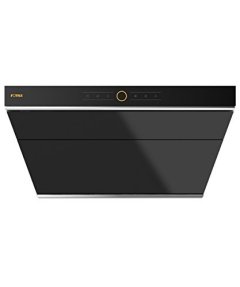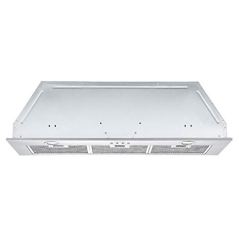BestReviews is reader-supported and may earn an affiliate commission. Details

One of the higher quality range hoods available for online purchase, this attractive piece is sure to impress.
Offers a touch screen for ultimate accessibility along with 3 speed settings. Built-in LED light. Double fan system for ultimate power. Sleek design.
A few buyers had issues with the company's customer service.

This remarkably inexpensive model is perfect for those looking to save a few dollars in their range hood purchase.
Available for purchase in various sizes and colors. Lamp lens distributes light evenly. Offers filtration system to rid area of smoke and odors.
Installation is noticeably difficult. Non-ducted design cannot offer outside venting.

A popular option for those wanting a simple, no-nonsense machine with top performance.
LED lights are constructed into range hood. Dual motors offer supreme airflow. Option to purchase at 800 CFM or 900 CFM. Removable oil filter for easy cleaning.
Many customers had problems with the product's LED lights being either defective or too dim.

Customers looking for a subtle, under cabinet range hood should check out this contemporary purchase from Chef.
Many customers appreciate the modern design with built-in digital clock and touch screen. Offers 3-way venting. Dishwasher-safe baffle filters.
Some owners noticed the item arrived damaged from shipping.

Those searching for a built-in range hood with helpful features will find their match in this larger model.
Company offers unit in 2 size options. 3-speed controls for ultimate functionality. Built-in LED lights. Panel filters are dishwasher safe.
Product tends to be louder than other comparable models. Extremely bright LED lights.

We recommend these products based on an intensive research process that's designed to cut through the noise and find the top products in this space. Guided by experts, we spend hours looking into the factors that matter, to bring you these selections.

The smell of a home-cooked meal is a unique comfort, but the smell of burning food? Not so much. That’s why an insert range hood is a necessity for any kitchen to help vent smoke and circulate the air. It also offers built-in features like a light, timer, and clock to increase your kitchen’s overall convenience.
Often called a powerpack range hood or undermount, an insert range hood is installed above your stove and can come in a number of sizes and shapes. It fits in custom cabinetry or a hood surround, integrating functionality without sacrificing aesthetics. In fact, with the right model, your insert range hood can add to the “wow” factor of your kitchen.
Insert range hoods aren’t without drawbacks, though. They tend to be more expensive than traditional range hoods and require more customized installation. In particular, they require a pathway to vent the air, as well as the proper adapters and wiring to provide power. That said, if you want an insert range hood for your kitchen, look no further than our buying guide and recommendations to get your shopping started.

One of the biggest advantages of an insert range hood is its flexibility, which means the size and fit vary from one installation to the next. For most, it should come close to mirroring the size of your cooktop so it can efficiently catch the smoke, food particles, and grease that drift upward. Keep in mind that the ductwork for an insert range hood resides inside cabinetry, so you’ll need to confirm that there’s enough space for it. Buyers often consult with designers and contractors to come up with a clever, personalized way to hide their range hood from view.
Insert range hoods are made of a variety of materials, the most common being aluminum and stainless steel. Both are similar in terms of utility and ease of cleaning, though aluminum is lighter. For most shoppers, the primary consideration here is how the insert range hood fits in with their existing kitchen décor.
How powerful an insert range hood is determines how quickly and efficiently it can vent smoke and heat from your kitchen. This power is measured in cubic feet per minute (CFM), and the amount you need depends on what and how often you cook.
If you cook a lot, particularly with hot oil, steam, and foods with strong odors, we recommend a hood with at least 350 cubic feet per minute. A solid rule of thumb is 1 CFM of ventilation per 100 British thermal units (Btu) of cooktop/range power. That means if you have a high-output burner with 50,000 Btu, look for an insert range hood in the area of 500 CFM. Remember that the higher the cubic feet per minute, the louder the hood fan is likely to be.

Range hoods offer a lot of utility outside of ventilation, and a great example is lighting. Depending on the model you choose, an insert range hood can have incandescent, fluorescent, halogen, or LED lights to help you see what you're cooking. Even cheaper models boast at least one light, with more expensive choices including four or more. Some even have a nightlight setting.
Fan: Having multiple speeds allows you to adjust the range hood fan according to the food you’re cooking. If you’re firing up all the burners and the oven, turn the fan to high. If you’re preparing a small midnight snack, use the low setting to cut down on noise. Most range hoods have at least two speeds, but some have three or more.
Touchscreen: For a luxury look and feel, some insert range hoods have touchscreen controls for the fan speed, light, clock, and timer. Select models even include a remote.
Indicator lights: Just like in your car, warning lights and indicators are helpful reminders when your appliance needs maintenance. High-end insert range hoods have indicator lights to let you know when the grease trap, air filter, or motor needs attention.
Sensors: As a safety measure, some insert range hoods include heat sensors that can detect fire and turn off your unit if needed.
Auto shutoff: An automatic shutoff feature can power down the vents after a certain amount of time to save electricity.
Proper wiring is extremely important for the efficiency and safety of your insert range hood. We recommend hiring a professional for this, but if you’re the DIY type, refer to all applicable codes and standards, including fire-rated construction.
Inexpensive: On the whole, insert range hoods are more expensive than the alternatives. You can find entry-level stainless steel models with at least one light for $80 to $100, but these are likely to be ductless, simply recirculating air and heat instead of venting it outside.
Mid-range: At $150 to $300, you have several larger, vented options at your disposal. Cubic feet per minute ratings can vary wildly, but there are several powerful models with ratings at and above 750 CFM. Expect more features at this price point, such as additional fan speeds, lights, timers, and the like.
Expensive: Pay more than $350 or so and you’ll find premium range hoods with unique exterior finishes, touchscreens, and extremely powerful motors with high CFM ratings. If you want a customized mount, special color, and other unique features, you can easily spend $1,000 or more.


A. Given your range hood’s proximity to grease, dirt, and smoke, it’s important to clean it properly. The sides and top of the range hood should be fairly straightforward to clean because you’re simply wiping down smooth sections of stainless steel or aluminum. Avoid using abrasive cleaners, acids, or scouring pads. Even paper towels can be too rough and risk scratching the finish. With that in mind, apply a mild detergent, glass cleaner, or specified metal cleaner to a soft cloth and wipe the exterior in the direction of the grain. Acetone can be used to remove heavy grease and oil.
With the outside clean, turn your attention to the underside of the insert range hood — the element that faces the stove and draws out air. This part is important because it’s where the baffle filters are, the filters that block grease and funnel it toward grease traps and away from the hood’s blower. If these are cleaned regularly, the motor will last significantly longer. Baffle filters are typically easy to remove and can be cleaned using the same method as the exterior. Depending on the model, the baffle filters may even be dishwasher safe.
A. There are several types of range hoods on the market. Insert range hoods are highly sought after due to their flexibility and aesthetics, but other styles certainly have their upsides too.
Ductless: Instead of venting air to the outdoors, ductless range hoods simply direct heat and smoke away from your range. They have baffle filters to trap oil, grease, and odors, but the effective ventilation is obviously much poorer. These are typically the least expensive type.
Wall mount: These range hoods are similar to insert range hoods only without the cabinet. Often called wall chimneys due to their narrow, vertical shape, wall mount range hoods offer very effective ventilation with a unique look. They’re generally more expensive than similar cabinet-mounted range hoods.
Island: Designed for stoves installed in the middle of the kitchen, these sleek range hoods vent air through ducts in the ceiling. They can be quite expensive.
Downdraft: If your stove is in the middle of the kitchen but an island range hood isn’t a good fit, consider a downdraft range hood. These push air and smoke down toward floor-mounted ducts, which are significantly easier to install than wall or ceiling ducts. That said, you’re working against the natural upward flow of heated air, so these are the least efficient in terms of ventilation.
A. For some, an over-the-range microwave might seem tempting as a replacement for a range hood. For one, it allows you to mount a microwave in an aesthetically pleasing way, and it usually has lights, a timer, and venting system built in. However, even the best over-the-range microwave won’t vent as well as a dedicated range hood. If ventilation is a secondary concern, though, and you’d like to free up some counter space, it might be worth a look.
Get emails you’ll love.
Learn about the products you’re wondering if you should buy and get advice on using your latest purchases.
